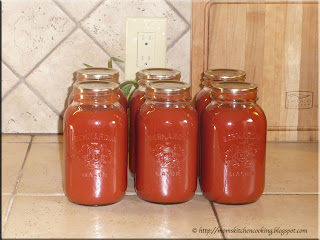One of my goals with home canning is creating a few convenience products for the pantry. I have to tell you I don't can a lot of whole, diced or crushed tomatoes because I can take the tomatoes to the next level before canning. This means I prefer canning tomato sauces and ready to use tomato products over plain tomatoes if I have to make a choice. I canned 7 - 750 ml and 6 - L jars of tomato purée. Tomato purée is thinner than tomato paste but thicker than tomato sauce. It unseasoned so can be used as a base for tomato based sauces, ketchup, soups and tomato powder.
The manufactures made a bit of a change realizing folks were reusing the jars for home canning although I think a more likely explanation was to cut down production costs. They have gone to a smaller mouth, thinner thread on some of their sauces so the mason rings will not fit even though the jars continue to be embossed with 'Atlas mason'. If you are buying commercial sauces specifically for the purpose of reusing them for home canning, take a mason jar ring with you. Avoid any sauce with the thinner lid fitting the thinner rims. Jars that can be repurposed for home canning will have a lid with a band the same depth as a mason jar ring.
The jars pictured have been in service for about 10 years without a problem. I've had no more breakage than using regular mason jars which is minimal to begin with. The risk of any scratches in the jar are minimal because any frugal homemaker would use a spatula not a knife to get the last remains from the jar. The jars are 750 ml rather than 500 ml or a L which is an off size for home canning jars. In this case the jars are processed to the next largest size so I processed according to the 1 L size (20 minutes at 10 lb pressure).
I canned the second batch of tomato purée in 1 - L mason jars. While this is a new product in the pantry, it will be one that graces the shelves from now on. Something tells me I did not can enough of it!
Tomatoes and tomato products tend to separate during storage due to the release of the enzyme pectase (pectinesterase) that is released when the tomato is cut. A special process is used to prepare the tomato purée to prevent it from separating. This involves heating a small amount of the purée quickly over high heat then slowly adding in the remainder of the purée in small amounts while continuing to cook. I started with about 750 ml of the purée. Once that came to a boil I stirred in about 500 ml of the raw purée. I continued in this fashion until all the purée had been added and was fully cooked then boiled the purée down a bit to get the right consistency. The result was a beautiful tomato purée ready for the pantry and doesn't it just look lovely?







0 food lovers commented:
Post a Comment